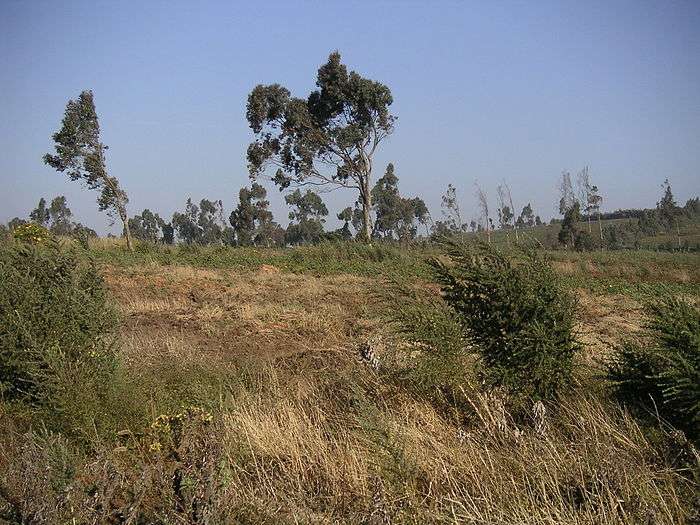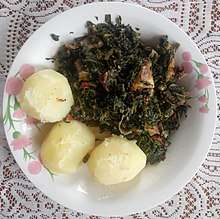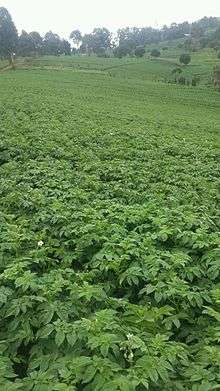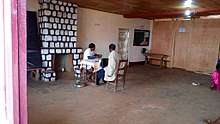Mmuock Leteh
Mmuock Leteh (IPA: [m̩muɔk lətɛʔ]) is a community of the Mmuock tribe. Administratively, it is found in the Wabane subdivsion of the Lebialem Division in the Southwest Region of Cameroon. Located at 5.675°N/10.041°E, it is the last village on the northwestern border with the West Region of the country. Colonial administrators called it Fotang after the name of the traditional ruler. As a result, the village is today alternatively known as Fotang, and that name is retained on some administrative maps of Cameroon and on satellite imagery.

Mmuock Leteh Fotang | |
|---|---|
Commune and village | |
 From top (L-R): main market crop potato, Mandzong group performs, students of the St John Paul II college sing the national anthem, early morning traders at the local market, partial panoramic view of Ntemndzem | |
| Etymology: lètǽ'lé (IPA: [lətɛʔlə]) (to be not quite agreed upon) | |
| Nickname(s): Leteh, Fotang, Bamock Fotang, Mmuock Fotang, Nkọolaq | |
 Mmuock Leteh Location of Mmuock Leteh (Fotang) in Cameroon | |
| Coordinates: 5.675°N 10.041°E | |
| Country | |
| Division | Lebialem |
| Region | Southwest |
| Ethnic group | Bamilike |
| Founded | ca 1760 |
| Founded by | Nkemtang |
| Divisions | Quarters
|
| Elevation | 2,496 m (8,189 ft) |
| Highest elevation | 2,740 m (8,990 ft) |
| Demonym(s) | Ŋeqleteh (IPA: [ŋeɣletɛʔ]), Mbaleteh (pl.) |
| Time zone | UTC+1 (WAT) |
At 2740 m asl, it has one of the highest peaks in Cameroon located in Maleta. The climate can be termed temperate, with night temperatures occasionally falling below 10 °C and the lower regions characterised by fog during the day.
History
Mmuock Leteh is part of the Mmuock tribe and, hence, shares the same early history with the other Mmuock villages.
Evolution from the Mmuock group
Not much is known about the Mmuock people prior to the 18th century. According to oral history, they at one point settled at a place called Bezeq Føka (IPA: [bəzəɣ fɯka][1]) in the present-day Menoua division of the Western Region. Thence, they migrated to a locality which today lies in Bafou and is called Fem Mmuock (meaning ruins of the abandoned location of Mmuock) by Mmuock people, and "Femock" by Bafou people . Eventually, the people split into two groups of two factions each, and each group went off in a different direction. One group included followers of a man called Nkemtang. They moved northwards and settled at a place today called Fem Leteh (IPA: [ʔə.fəm lətɛʔ]), meaning ruins of the abandoned location of Leteh. There, they founded the village of Mmuock-Leteh. Nkemtang, who was the group's leader, was renamed Fotang (IPA: [fɯtaŋ]) and became the village ruler. (In the Mmuock language, the prefix Nkem[1] (IPA: [ŋkəəm]) denotes a notable of high rank; Fø (IPA: [ʔə.fɯ]), on the other hand, is the highest rank and signifies a ruler.) As the Nkemtang faction had been the largest, Leteh was known amongst the other Mmuock communities as Nko'olaq (IPA: [ŋkɔʔɔlaɣ]) (meaning the larger section).
From the then Fem Leteh, Leteh people migrated into the hinterlands and settled at Mbammuock (the residence of Mmuock), also known as Ndzem-Nko'olaq (the rear of Nko'olaq). In the late 70s and early 80s, Leteh people starting migrating from the forest region around Mbammuock, to the grassland areas up in the hills at about 2400 m above sea level. This resulted from the need to cultivate market garden crops such as potato, garlic and carrots.
Etymology
The name Leteh comes from the Mmuock verb lètǽ'lé (IPA: [lətɛʔlə]) meaning: to be not quite agreed upon, to be not quite set. They were so-named because Nkemtang's faction never could agree on any strategy before setting out, and tended to improvise as they went along.
Geography
The relief of Mmuock-Leteh is irregular. The village lies on the summit of the Bamboutous Mountain ranges: The Maleta Plateau is at 2740 m above sea level, and is the third highest point on the Western Cameroon Highlands. The relief is very accidented in some places characterised by mountain peaks—each of which is called Ntǿ (IPA: [ntɯ]) in the Mmuock language—, steep rolling and pyramidal hills separated by very incised river valleys and ravines.

Mmuock-Leteh occupies part of the western half of the semi-circular caldera[2] that attracts several tourists annually. The village is further defined by a concentric alignment of necks and domes known locally as Mntǿ (IPA: [mntɯ]) or peaks. Examples of such peaks include Ntø Maleta (2740 m), Ntø Mangua (2710 m), Ntø Tiahchia, etc.
Mmuock-Leteh has a tropical mountainous climate of the sub-equatorial type. The accidented nature of the relief has greatly influenced this climate which is characterised by a long rainy season (mid-March to mid-November) and a shorter dry season (mid-November to mid-March). The monthly rainfall ranges between 35 mm in January and 605 mm in August, August being the wettest month.[3] The temperature varies between 8 and 28 °C: In altitudes above 1800 m asl, night temperatures fall as low as 8 °C during the rainy season.
The soils are volcanic, fertile and rich for agricultural production. (This has led to Mmuock-Leteh farmers winning prizes at the national agro-pastoral shows in Cameroon: in potatoes, carrots and other vegetables). The soil comprises a vegetal material at the summit (35 cm), followed by a humified horizon of 35 to 40 cm, a tertiary horizon and a clayey horizon. These soils have been largely altered and impoverished by erosion and landslides, leading to the loss of much of its organic materials. The 2003 landslides led to destruction of crops, livestock and infrastructure.

The village is covered by a herbaceous Savannah grassland dominated by plants (Poacées and Cyperacées), eucalyptus saligna trees and gallery forest in the lowland areas. Some of the grass species found here, include Cloris sp, Cypérus haspan, Paspalum polystachion, and Axonopus compressus. The forest areas are covered by trees such as pronus africana, raffia palm, and kolanut trees. Until the early sixties, the lower forest zone harboured several birds and animal species. These included monkeys, chimpanzees, porcupines, squirrels, deers, etc. Extensive poaching has, however, led to the eradication of these animals.
Culture
Mmuock people generally have the same culture. Being of the Bamilike ethnic group, they have a very similar culture to the bordering communities of Bangang, Bafou and Fongo-Tongo, all in the West Region of Cameroon.
Religious beliefs
Although Christianity has been adopted in recent times, Leteh people still adhere to beliefs and practices of traditional religion. At the founding of the village, several shrines were created and dedicated to each of the primary gods of the village. Prominent families typically have a shrine dedicated to the gods of the family; such shrines are usually located at the entrance into the family compound.

The dominant Christian denomination is the Catholic church which displaced the Presbyterian church. Two reasons led to the prominence of the Catholic church. While the lone primary school in the village (P.S. Fotang) was taken over by the government, Catholic School Leteh was created. Secondly, the Presbyterian Church did not have a committed presence in the village. The establishment of St Anthony's Catholic Church and regular visits from priests, caused more and more people to attend the catholic mass. The Divine Mercy Quasi-Parish was created in 2013 with permanent priests.
Cuisine
The traditional food of Leteh is aPáláh (IPA: [apalaʔ]). It is prepared by pounding taro in a mortar using a pestle, and is served on cocoyam leaves and eaten with the finger. It is served with either yellow soup or with black soup. In the Western part of Cameroon, a very similar meal is called achu. The difference between achu and aPáláh is that the latter is made purely from colocasia, while achu sometimes includes bananas and varieties of cocoyam.
Due to a decline in the production of cocoyams, Ṗáláh has decreased in popularity and been supplanted by meals based on Irish potato. As today's most familiar crop in Mmuock Leteh, the potato forms the basis of the most popular meals.
Preparation of traditional meal
aPáláh is made from taro (Colocasia esculenta). Two people are usually involved in the mashing or pounding process: one peels and the other one pounds. Traditionally, the taro does not require any ingredient, although today special bananas may be added. The resulting paste is wrapped in fresh taro leaves and served with yellow soup.
The yellow soup is made by stirring palm oil in warm water including potash limestone (Kàgnùà). Ingredients may include common salt, pepper, white peeper, and all variety meat and fish. Apart from yellow soup, black soup is also used. It is made from boiled taro leaves with the same ingredients as the yellow soup.
Common meals
- Mankœäh ncuúūh. The name of the meal comes from Mankœäh (Irish potato) and ncuúūh (the past participle of lècúh, to pound).This meal is mashed Irish potato mixed with beans (more often black beans). The beans areboiled in advance since they take a longer time to be done. The potatoes are boiled separately and the beans added 5 to 10 minutes before mashing begins. The mixture is mashed in a pot using a pestle. The beans tend to remain intact at the end of the process. Ingredients are palm oil, kitchen salt, and pepper.
 Mankœäh ncuúūh, a meal of mashed potato and beans
Mankœäh ncuúūh, a meal of mashed potato and beans
- Mankœäh šiíīt (potato porridge). The name derives from šiíīt, the past participle of lèšīt (to stir). Mankœäh šiíīt is potato porridge. It is prepared by peeling Irish potatoes and boiling them together with freely-chosen ingredients such as vegetables, assorted spices, and meat.
- Mankœäh mahteéngwàng The name comes from lèmahtē (to sprinkle) and Ngwàng (salt). These are cooked Irish potatoes that have been boiled with salt to taste, and eaten with vegetables (such as cabbages) or stews.
 Mankœäh mahteéŋgwàng
Mankœäh mahteéŋgwàng
- Bekéqńgesàng . This is called corn-chaff in the local pidgin English. It is beans and corn cooked together. The skin is optionally peeled off the corn eyes. The corn is cooked first and beans added later. Ingredients depend on individual choice, but the most common are: palm or vegetable oil, kitchen salt, grinned ginger, garlic, pepper, white pepper, onion; cow skin, magi, and meat or fish.
- Besanggnà. It is a thick paste-like meal made from corn flour. The cornflour is filtered through a special sieve, separating the fine particles from chaff. The chaff is further washed to remove the corn skin. What remains is stirred in boiled water for a while, then the sieved powder is mixed to it. The entire meal is stirred until it gets ready. It is wrapped with fresh banana leaves and also eaten with hands.
Marriage
Befák
Rituals for the dead
When a person dies, one or more funeral rites may be performed. The kind and number of rites depend on the deceased's age, rank, and gender.

Succession and kinship
Polygamy, specifically polygyny, is the norm in Mmuock Leteh.
Inheritance and succession passes through the male line. A man is expected to choose a successor (Njœêndíǽ) before dying. After death, his titles and possessions go by default to the male heir, unless the deceased had made a will or specifically assigned certain possessions to other relatives, for example, which child gets what. In the early days, the will was verbal, told to an intimate friend. Nowadays, it is written and handed to at least two friends for fear of alteration. The first-born (Mbviemù) cannot succeed the father.
Wives, too, may have successors. However, a wive's successor does not always need to be expressly stated: it is by default her last child, irrespective of the child's gender; she could also have specified a grandchild. Grandparents also have successors irrespective of gender. These category of successors must not necessarily be designated by grandparents. They are designated even after their death, and there is no unique rule on chosen the successors; individual families do so based on individual choice and significance.
Education
The first primary school in Leteh started in 1946 in Mbamuock. A Presbyterian school, it was at the entrance into the compound of Tatenkœang (IPA: [tatəŋkɨaŋ]), some 200m up from the palace. Mr Enderley, accompanied by his wife Paulina, was the teacher; the first pupils, Chiatiah (Peter) and Sobetamu (Daniel), were his servants. Many promising pupils were sent away to places as far away as Bali, and the school was moribund before another Presbyterian school, called PS Fotang, was opened higher up at Belang Quarter in 1959.
PS Fotang continued until about 1985 when, with the withdrawal of the Presbyterian church from many primary schools, government took control of the school and renamed it GS Fotang. In 1985, a Catholic School, CS Leteh, was created. Located at Ntemndzem, it is, in terms of population, the biggest catholic primary school in the Mamfe diocese. Two additional public primary schools have since been added; these are GS Maleta and GBPS Ntemndzem.
There are three secondary schools in the village, all located at Ntemndzem. They are GSS Mmuock Leteh, GTC Ntemndzem (a public technical college), and the John Paul II College (a catholic school).
Agriculture

The population of Mmuock Leteh engage in agriculture and livestock breeding as their primary occupation. Although the main market crops are Irish potato and carrots, a diverse range of crops are produced, such as leek, cabbages, beetroot, garlic, maize, and beans.
Health
Mmuock Leteh has an Integrated Health Centre and the Divine Mercy Health Post (a catholic health post) which, together, receive and attend to the healthcare needs of hundreds of patients annually. The Integrated Health Centre was opened in 1992 as a community development project. It was managed by the Health Commission of the Mmuock Leteh Cultural and Development Association (MULCUDA) until early 2009 when it became integrated and management was handed over to the government under the Fotang Health Area, Wabane Health District. The Catholic Health Centre was opened in 2016 as an extension of the Catholic Health Initiative under the Mamfe Diocese.

The users of these health centers are mostly Mmuock Leteh denizens but a significant number of patients come from neighbouring villages seeking healthcare services. They offer all the services included in the minimum package as stipulated by the ministry of public Health which cover Laboratory tests, wound care, deliveries, Antenatal Consultations (ANC), Infant Welfare Clinics (IWC) and vaccinations.
Just like many other Health Centers in Cameroon, these two face similar difficulties including under staffing, under trained staff, lack of equipment and a difficult terrain which hinders community outreach efforts. Unfortunately also, the Wabane Health District is one of the few which does not have a District Hospital out of the 135 Health Districts in Cameroon. This makes patient referrals and counter referrals very difficult and occasionally, some critically ill patients have died on their way to better equipped centers in loung or Dschang in the Western Region.
Alternative medicine
Contemporary and traditional medicine have always coexisted in Cameroon sometimes with occasional rivalry. However, collaboration between both has been greatly enhanced since the ministry of public health officially recognised and integrated traditional medicine in the national health structure. In fact, the Chief Medical Officers (CMOs) are officially responsible for supervising the activities of traditional doctors in their district.
Traditional medicine is quite well developed in Mmuock Leteh, particularly the use of medicinal plants. In fact, the locality has a wide variety of medicinal plants, due to the uniqueness of its climate and many plant varieties that are relatively well exploited and used by traditional doctors. Before the opening of the first health centre in Mmuock Leteh, traditional medicine was central in the fight against disease and pursuit of health. The population has often resorted to this type of medicine, especially in rural areas and among the poor population because of the high costs of medical care and modern drugs as well as a deeply held believe in its efficacy.
In recent years, many scholars in the village have criticised traditional medicine practises arguing that it involves the use of plants including those whose efficiency, dose and harmlessness to humans have has not been determined. They have equally heavily criticised traditional medicine practitioners for their tendency to promote or engage in superstitious activities and witchcraft, including the dangerous prevalent practice of doing autopsies on corpses in order to determine the cause of death, which usually is concluded as witchcraft.
References
- Fotang, Tano (2011). The Sound of Mmuock (Vol 1: Orthography) (first ed.). Bamenda: Magnolian Publishers. ISBN 978-9956-645-17-6.
- Ojuku Tiafack, Ph.D. (2012). "The Geography of Mmuock-Leteh". Mulcuda Silver Jubilee Magazine. Bamenda: Magnolian Publishers.
- Peter Nkangafack Chateh (1972). M'mock Villages (Bambutu): A Geographic Study (M.A.). Yaounde: University of Cameroon.